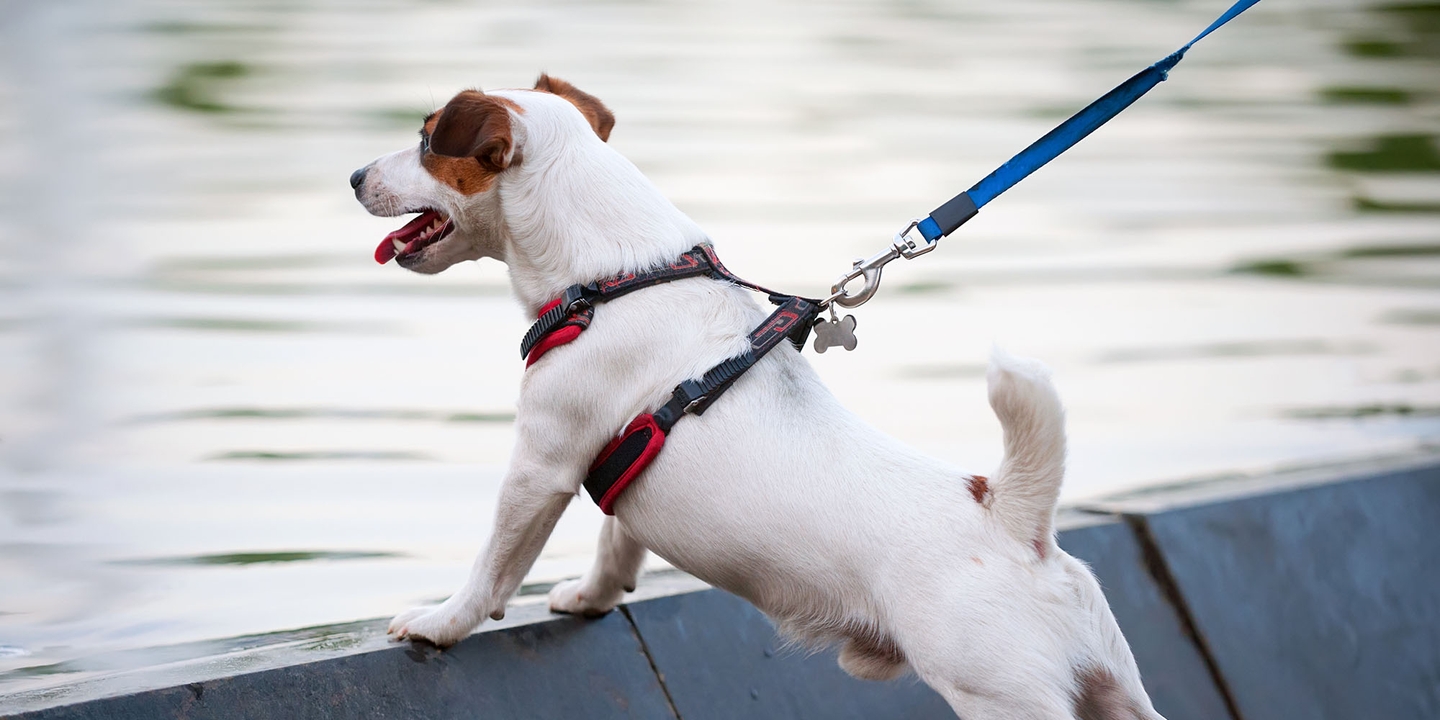Dog harness vs collar: Which is better for your pup?
4 min read
Which is better, a dog collar or a harness? Whether you’re taking your dog for invigorating walks or training a newly adopted puppy, you’ll need to make a choice—and there’s a lot to consider. Does a harness work better for training? Is a collar easier for short walks? We’ve got the lowdown on the harness vs collar debate and exactly what you should consider before buying either one.
Pros of dog harnesses
There are two main types of dog harnesses: one where the leash clips on the back and one where the leash clips in front. Both bring quite a few benefits to the pup and owner.
Harnesses are tough to escape
Harnesses are tougher to escape from than collars. So if you have an adventurous or wily dog, a harness might be a better option.
Harnesses bring fewer health risks
In general, harnesses are easier on dogs than collars. For example, a good harness can alleviate back pain. They’re also far less likely to pull on your dog’s throat, causing injury. If you have a dog that loves to pull hard while walking, you’ll want to consider a harness.
Certain varieties cut down on pulling
Harnesses (especially the front-clip variety) can cut down on your dog’s tendency to pull as you walk. Because harnesses cover more of your dog’s surface area than a small collar does, the pressure is spread out more, giving you more control as you walk. This can ultimately make the walk easier on both of you.
Cons of dog harnesses
Of course, dog harnesses aren’t perfect. They have some disadvantages, too.
Achieving a proper fit can be tough
Harnesses can be a little more difficult to put on and take off, at least until you get used to them. A harness’s fit is also very important. Your dog can escape from a harness if it’s too loose, but if it’s too tight it can be painful. Even if the fit is good, some dogs take a little time to get used to their harnesses. So you’ll want to test your dog with the harness before going on your first journey together.
Back-clip harnesses may encourage pulling
While front-clip harnesses discourage dogs from pulling, harnesses that clip on the back might train your dog to pull more. This is especially likely with breeds that are bred to pull, such as Siberian huskies.
Pet ID tags are tougher to wear
If you’re using a harness, you’ll need to get creative about where to keep your dog’s ID tags. Some harnesses have an extra ring where you can clip the tag. Or you might want your pup to wear an ID collar with the harness. And of course, a microchip is a must-have whether you’re using a harness or a collar.
Sometimes harnesses can be uncomfortable
Some dogs may find harnesses uncomfortable. Long-haired dogs’ fur may get caught in harnesses more easily than in dog collars. If the fit isn’t good, it might cause chafing.
Pros of dog collars
While harnesses certainly have a lot of advantages, using a dog collar comes with benefits, too.
They’re easy to wear
Dog collars are so common that you’re likely already using one. All you need to do is clip on the leash and go. It’s a much faster process than putting on your dog’s harness. And since your dog likely already has their ID tag and rabies tag on their collar, you don’t have to worry about taking those items with you.
Collars come in many varieties
Collars come in many styles, including flat collars, limited slip (or martingale) collars, and rolled collars that don’t mat your dog’s hair.
They’re less physically taxing to use
Walking a dog with a leash and collar may require less physical strength than walking a dog with a harness. This is because you have more leverage with a collar since the leash is fastened around the neck instead of on the back. Harnesses that fasten in the front might also give you a little more leverage.
Cons of dog collars
Unfortunately, dog collars also bring disadvantages, whether you’re walking an adult or senior dog or a puppy.
Your dog might escape if the collar isn’t fitted well
Dogs can escape from collars that aren’t fitted snugly enough. But if they’re too tight, they can be painful. So finding a good fit is just as important with a collar as it is with a harness.
Certain medical conditions can be made worse
A collar can exacerbate some dogs’ preexisting medical conditions. This is especially true for dogs with back issues, glaucoma, or a history of neck or trachea problems.
Some dogs may develop new health problems
Unfortunately, healthy dogs can develop some issues from using a collar. Collars can cause back pain or damage a dog’s throat, especially if the dog tends to pull a lot while walking.
Your veterinarian may advise you to avoid certain types of collars altogether. For example, choke collars and prong collars can seriously damage a dog’s neck.
Is a harness or collar better for puppy training?
In general, it’s better to start your puppy’s leash training with a harness and move on to a collar later. This is because puppies tend to pull strongly when first learning to walk on a leash. A collar might push on your puppy’s trachea when they pull, possibly damaging it. So start with a harness that clips on the back to minimize pulling. Once they learn not to pull through positive reinforcement training, you can start trying collars.
Do certain breeds do better with harnesses or collars?
Some dog breeds are a little extra fragile, and might be better served with the protection that a harness offers. Here are some examples: Small toy breeds are less likely to injure their throats using a harness.
Any dog that’s had throat or neck issues in the past needs a harness. Breeds with flatter snouts (known as brachycephalic breeds) need a harness.
Breeds prone to back issues should use a harness. For example, Dachshunds have fragile backs, so they need a harness instead of a collar. Any dog with glaucoma or other eye issues should use a harness, as pulling on a collar can increase pressure around the eyes.
Which is better, a harness or a collar?
Harnesses and collars both have disadvantages. Both can be painful if worn too tight. Your dog can escape either one if it’s not snug enough. And whichever you choose, you’ll need to double-check the fit.
But some breeds of dogs, like toy breeds and flat-faced breeds, simply shouldn’t use collars. And other dogs with a history of back, throat, or eye problems should use harnesses.
When it comes to collars and harnesses, there’s not a one-size-fits-all answer. If you’re unsure, ask your veterinarian. Your veterinarian’s advice might even vary depending on if you’re going for a quick potty break outside or a long hike in the woods. The decision is often specific to the individual dog.
You can also get advice from Pets Best’s 24/7 Pet Helpline for policyholders. Get a quote and enroll your pet today so you can be insured and ready for the unexpected.





